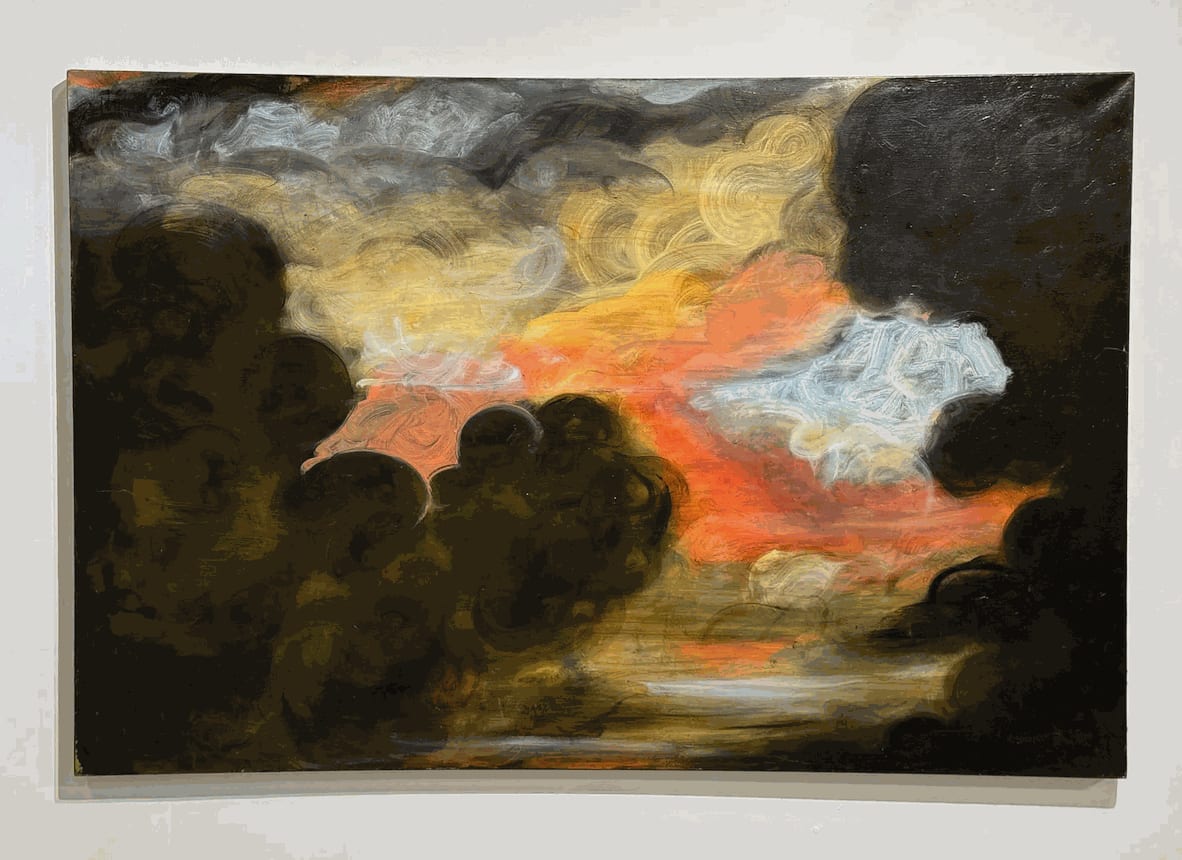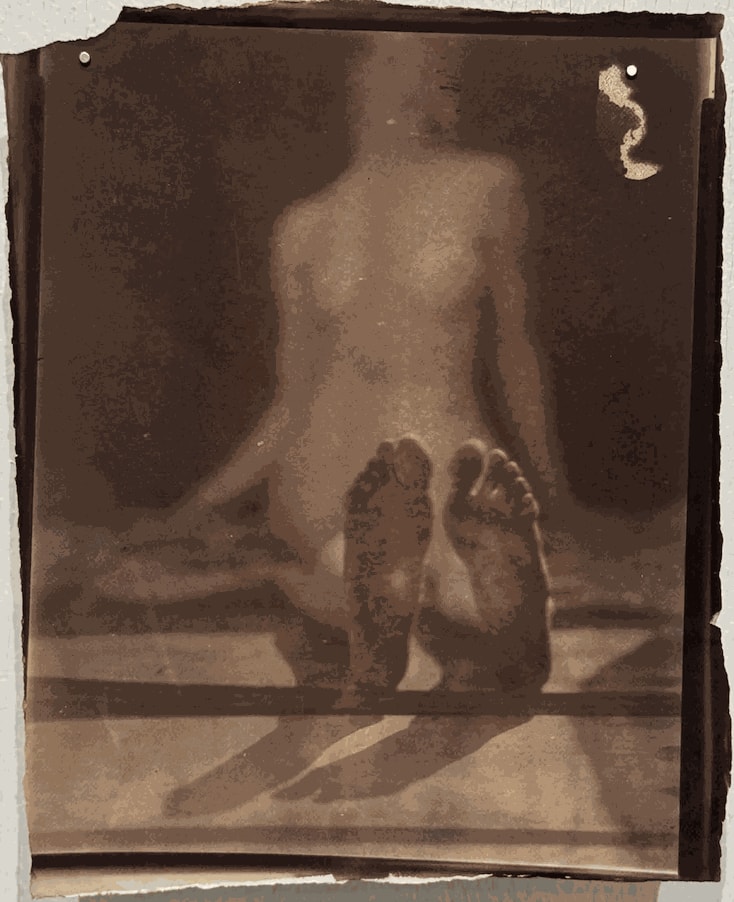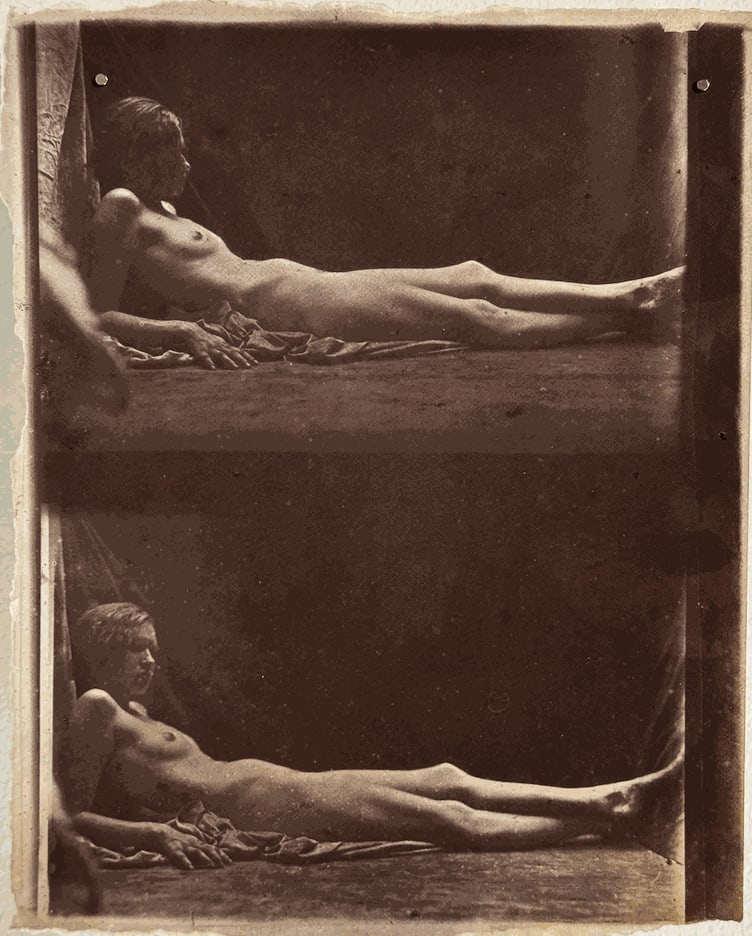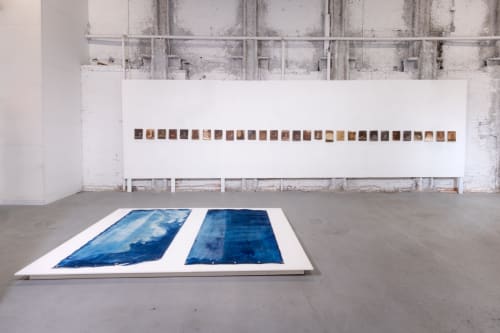Hal Hirshorn: Surrender Everything to the Sun
Ethan Cohen Gallery
March 27–May 10, 2025
New York
Hal Hirshorn (1965–2025) was probably better known for his presence in the art world than for his work. He was a photographer and painter, a thinker and a raconteur. Isaac Aden, who knew him well toward the end of his life, when he passed away suddenly, organized this exhibition at Ethan Cohen’s two New York galleries. It was homage and memorial but also an argument for the quality and relevance of work that has been too little seen. At the same time, it was an opportunity to rethink once again the age-old relationship between painting and photography.
The exhibition consisted of three distinct elements: gestural paintings of landscape and clouds; salted paper photographic prints, mostly of nude women in studio poses, and large abstract washes of Prussian blue on paper. The photographs were analogue prints, all shot with antique lenses and developed not in the darkroom but in sunlight. They were loaded with artifacts of their technology, from disconcerting depth of field and focal uncertainties to highly variable exposures. The exhibition was like walking into a hermetic and deeply eccentric revival of the nineteenth century in France. But you can’t step in any river twice—or even once—because change is the nature of modern art. Hirshorn’s work was so uncannily evocative of the past that it forced the question: what was he thinking?

Hirshorn was de facto a member of what I have dubbed the antiquarian avant garde in photography, a diverse group of artists who, for a variety of—often contradictory—reasons, adopted antique analogue processes. The engagements range from Sally Mann’s use of collodion-coated glass plate negatives to Jerry Spagnoli’s hallucinogenic daguerreotypes to Eileen Quinlan’s conceptually inflected use of damaged black and white film to Dan Estabrook’s doctored paper negatives and positives. None of these artists is a luddite. Many of them use digital tools, but they share misgivings about what Mann has described as “images that never come to ground.” Nevertheless, their work cannot be understood outside the digital revolution and the tide of images it has generated. These photographers and many more, regardless of their putative subjects, are engaged in the thematization of medium, compelled to examine every aspect of its production, history, and audiences in an attempt to understand why we take pictures, why we look, and whether images move us still.
In traveling forward into the past, Hirshorn touched what was for him the essence of photography’s poignant necessity. First was its aspect of spectral embodiment, its simultaneous evocation and revocation of the subject before the camera. So his nudes are wan and thin, in a contemporary way, there but not fully there in their exposure. They invite an erotic gaze but somehow short circuit it, and in deliberate reference to the political realism of Édouard Manet’s Olympia (1863) Hirshorn pays conspicuous attention to his models’ feet. Feet, of course, are where we all “come to ground” and engage our mortality as earthbound. But as fetish, they are also the part that seems capable of transcending that utility, their odd refinement more miraculous than hands. Dirty, delicate, and vulnerable. The photographs look rough, torn at the edges, as if the medium had just been invented, or as if Hirshorn had made it up on the spot to give shape to something he saw and felt.

Hal Hirshorn, Untitled, salt print, c. 2000–2025. Courtesy Ethan Cohen Gallery. Photo: Weston Andrews.
A sense of miraculous incongruity animates the work, expressed in Hirshorn’s description of his process as “surrender everything to the sun.” It is an ecstatic injunction, born of his contemplation of a mental, emotional, and technical act authorized by nature’s most mysterious force: light. Light, which brings out the latent image on the paper, bestows visibility, and makes life and art possible. In Hirshorn’s phrase it could be the sun-worshipping pharaoh Akhenaten speaking. Hirshorn’s sense of nature’s vaster presence marks him as a romantic despite his realism, and it clarifies his relationship to painting. In spite of their comparatively small size, the gestural extravagance of his landscapes—skyscapes really—manages to generate extreme momentum. Hirshorn studied painting at Bennington, with its gaudy history of modernist teachers. But his abstractions recall a different lineage: the cloud studies of John Constable, the atmospheres of J.M.W. Turner, the turbulent skies of Albert Bierstadt and Nicolas Poussin. His broad, swirling strokes create their own weather and bring the body into the process of rendering impressions in a way that photography can’t.

Hal Hirshorn, Untitled, salt print, c. 2000–2025. Courtesy Ethan Cohen Gallery. Photo: Weston Andrews.
And yet these photographs are also embodied works, in which nature has operated with a human assistant. Or rather say supplicant, someone who, as much by prayer as by preparation, is able to coax the forces of light, time, and chemistry into depositing on paper images of what cannot be seen—desire, mortality, time discretely passing.

